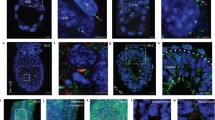Summary
Developing cilia and non-ciliated centrioles are both present in the rat choroid cell studied with the electron microscope. The development of the cilium begins with the appearance of a thick-walled vesicle close to the centriole or in contact with it. Very soon this vesicle lines the distal extremity of the centriole. The growing ciliary shaft invaginates the vesicle, forming a temporary ciliary sheath. This sheath isolates the growing cilium from its environment.
Degenerating ciliary shafts are by no means rare. They are interpreted as evidence of a biological cycle of the cilia. Club-shaped forms are also frequent.
Non-ciliated centrioles are sometimes in contact with striated structures consisting of alternating dark and light bands, separated by a distance of 600 Å. These formations (treillis) are different from the “pericentriolar satellites”. On morphological grounds, they might be considered as centriole precursors.
Similar content being viewed by others
Bibliographie
Bernard, W., et E. de Harven: L'ultrastructure du centriole et d'autres éléments de l'appareil achromatique. Vierter internationaler Kongreß für Elektronenmikroskopie, Bd. II, S. 217–227. Berlin-Göttingen-Heidelberg: Springer 1960.
Brightman, M. W., and S. L. Palay: The fine structure of ependyma in the brain of the rat. J. Cell Biol. 19, 415–439 (1963).
Cervós-Navarro, J., u. J. Vázquez: Elektronenmikroskopische Untersuchungen über das Vorkommen von Cilien in Meningeomen. Virchows Arch. path. Anat. 341, 280–290 (1966).
Doolin, P. F., and W. I. Birge: Ultrastructural organization of cilia and basal bodies of the epithelium of the choroid plexus in the chick embryo. J. Cell Biol. 29, 33–45 (1966).
Fawcett, D. W.: Cilia and flagella. The cell. Biochemistry, physiology, morphology (Brachet et Mirsky, eds.), vol. II, p. 217–298. New York: Academic Press Inc. 1961.
Gall, I. G.: Centriole replication. A study of spermatogenesis in the snail Viviparus. J. biophys. biochem. Cytol. 10, 163–193 (1961).
Grassé, P. P.: La reproduction par induction du blépharoplaste et du flagelle du Trypanosoma equiperdum (Flagellé protomonadine). C. R. Acad. Sci. (Paris) 252, 3917–3921 (1961).
Harven, E. de, et W. Bernhard: Etude au microscope électronique de l'ultrastructure du centriole chez les vertébrés. Z. Zellforsch. 45, 378–398 (1956).
Martínez Martínez, P.: Influence de la narcose sur l'image inframicroscopique de la cellule choroïdienne. C. R. Ass. Anat. 52, Réunion Paris-Orsay (1967) (sous presse).
Noirot-Timothée, C.: L'ultrastructure du blépharoplaste des Infusoires ciliés. C. R. Acad. Sci. (Paris) 246, 2293–2295 (1958).
Randall, I., and I. M. Hopkins: Studies of cilia, basal bodies and some related organelles, Part IIa: Problems of genesis. Proc. Linnean Soc. London 174, pt. 1, p. 37–41 (1963).
Reese, T. S.: Olfactory cilia in the frog. J. Cell Biol. 25, 209–230 (1965).
Renaud, F. L., and H. Swift: The development of basal bodies and flagella in Allomyces arbusculus. J. Cell Biol. 23, 339–354 (1964).
Rouiller, C. H., et E. Fauré-Fremiet: Ultrastructure réticulée d'une fibre squelettique chez un cilié. J. Ultrastruct. Res. 1, 1–13 (1957).
Sakaguchi, H.: Pericentriolar filamentous bodies. J. Ultrastruct. Res. 12, 13–21 (1965).
Scherft, J. P., and W. Th. Daems: Single cilia in chondrocytes. J. Ultrastruct. Res. (sous presse).
Sorokin, S.: Centrioles and the formation of rudimentary cilia by fibroblasts and smooth muscle cells. J. Cell Biol. 15, 363–377 (1962).
Sotelo, J. R., and O. Trujillo-Cenóz: Electronmicroscope study on the development of ciliary components of the neural epithelium of the chick embryo. Z. Zellforsch. 49, 1–12 (1958).
—: Electronmicroscope study of the kinetic apparatus in animal sperm cells. Z. Zellforsch, 48, 565 (1958).
Stockinger, L.: Beiträge zur Entwicklung und Ultrastruktur des Flimmersaumes. Anat. Anz., Erg.-H. 113, 43–52 (1964).
—, u. E. Cireli: Eine bisher unbekannte Art der Zentriolenvermehrung. Z. Zellforsch. 68, 733–740 (1965).
Szollosi, D.: The structure and function of centrioles and their satellites in the jellyfish Phialidium gregarium. J. Cell Biol. 21, 465–481 (1964).
Author information
Authors and Affiliations
Rights and permissions
About this article
Cite this article
Martínez Martínez, P., Daems, W.T. Les phases précoces de la formation des cils et le problème de l'origine du corpuscule basal. Z. Zellforsch. 87, 46–68 (1968). https://doi.org/10.1007/BF00326560
Received:
Issue Date:
DOI: https://doi.org/10.1007/BF00326560



